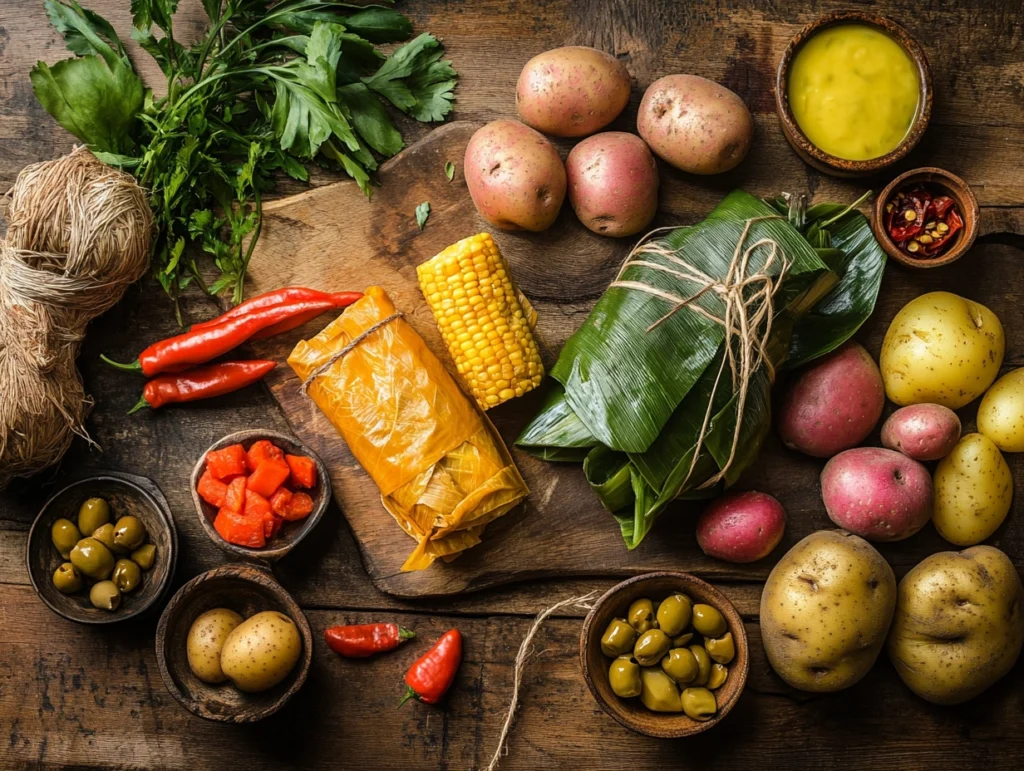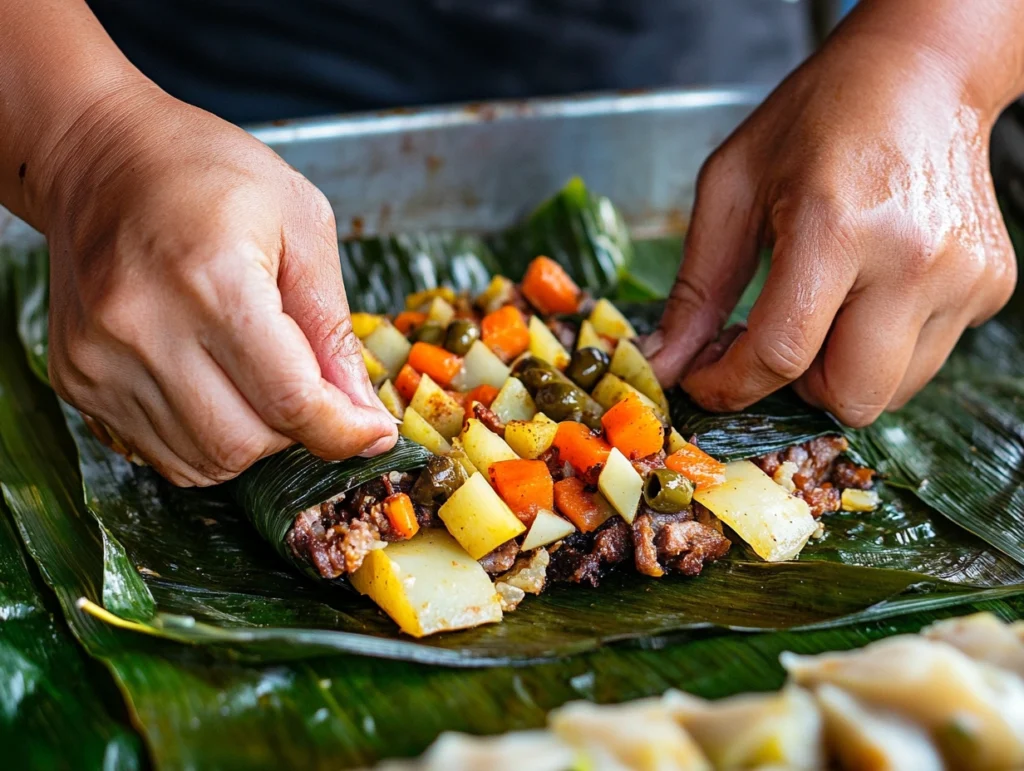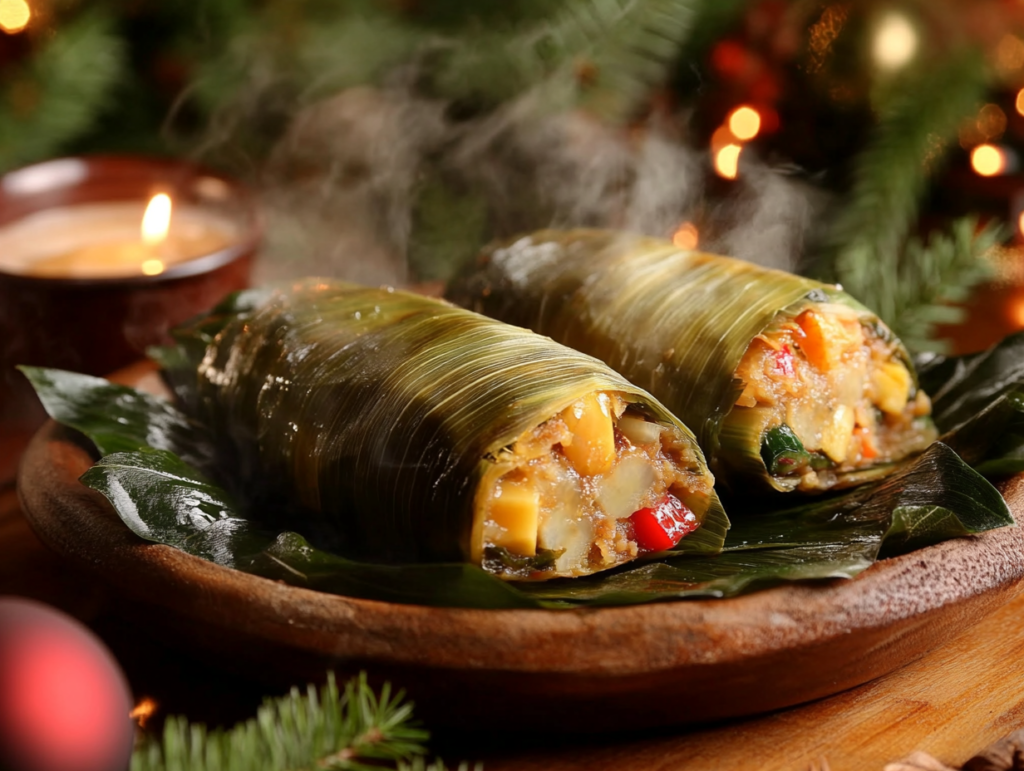1. Introduction
Costa Rican tamales are more than just a dish—they are a cherished tradition that has been passed down through generations. In Costa Rica, tamales are synonymous with family gatherings, celebrations, and the festive spirit of Christmas. These hearty creations, wrapped in banana leaves, highlight the unique ingredients in Costa Rican tamales and the vibrant flavors of their cuisine.
This article delves deep into the ingredients in Costa Rican tamales and explores how they come together to create a dish steeped in history, culture, and culinary artistry. Whether you’re an enthusiast of Latin American food or simply curious about this delicious tradition, you’ll leave with a better understanding of what makes Costa Rican tamales so special.
2. Historical Background of Tamales in Costa Rica
amales, with their roots in Mesoamerica, have evolved through time, incorporating the distinct ingredients in Costa Rican tamales that reflect the country’s traditions. Over time, cooks in different regions adapted these simple creations, evolving them with local ingredients and cooking techniques.
In Costa Rica, tamales hold a particularly special place in the nation’s history and culinary identity. During colonial times, people blended indigenous ingredients like corn masa with European imports such as pork and spices, creating the tamales we know today. Families traditionally prepare tamales in large batches during Christmas to symbolize unity and abundance. Families gather for a communal tamale-making session, known as a tamalada, where multiple generations contribute to the process.
Tamales are more than just food—they are a celebration of heritage. They reflect Costa Rica’s agricultural roots, with many of the ingredients sourced directly from local farms. The banana leaves used for wrapping and the aromatic fillings bring together elements that are distinctly Costa Rican.
3. Traditional Ingredients of Costa Rican Tamales
Cooks craft Costa Rican tamales using a careful selection of ingredients that balance flavor, texture, and cultural authenticity. Each component plays a vital role in creating the final dish. Here’s a breakdown of the key ingredients used in making traditional Costa Rican tamales:

Alt Text: Ingredients for Costa Rican tamales, including corn masa, pork, vegetables, and banana leaves, displayed on a wooden table.
3.1. Masa (Dough)
The foundation of every tamale is the masa, a dough made primarily from corn. Corn is a staple in Costa Rican cuisine and has been a dietary cornerstone for centuries. To prepare the masa, corn flour (masa harina) is combined with savory broth—typically made from pork or chicken—to infuse it with rich flavor.
- Corn Masa Mix: Provides the base structure and a subtle sweetness.
- Broth: Acts as the liquid binder, adding moisture and depth to the dough.
- Margarine or Pork Lard: Gives the masa a silky texture and richness, ensuring the tamales are tender and flavorful.
- Seasonings: Ingredients like chicken bouillon, salt, and sometimes achiote (annatto) for color enhance the taste of the masa.
The key to perfect masa is achieving the right consistency: smooth and pliable but not too sticky.
3.2. Fillings
The fillings are where Costa Rican tamales truly shine. A blend of proteins, vegetables, and flavorful extras creates a hearty and satisfying center.
- Proteins: Common choices include pork shoulder, shredded chicken, or beef. The meat is often seasoned and cooked until tender, ensuring every bite is packed with flavor.
- Vegetables: Root vegetables like carrots and potatoes add texture and sweetness. Red bell peppers provide a slight tang and vibrant color.
- Additional Elements: Raisins, olives, rice, and chickpeas are popular additions, offering a delightful contrast of textures and flavors. These ingredients reflect the influence of Costa Rica’s diverse culinary heritage.
Each tamale is filled with a carefully measured portion of these ingredients, ensuring consistency and balance in every bite.
3.3. Wrapping and Cooking
The distinctive flavor of Costa Rican tamales comes in part from their unique wrapping: banana or plantain leaves.
- Banana Leaves: These large, pliable leaves are used to encase the masa and fillings. They impart a subtle, earthy aroma during cooking.
- Kitchen Twine: Once wrapped, the tamales are tied securely with twine to keep everything intact.
- Cooking Method: Tamales are traditionally boiled in large pots of water. The process allows the flavors to meld together while steaming the dough to perfection.
4. Preparation Process of Costa Rican Tamales
While the ingredients themselves are critical, the method of preparation is equally important. The process of combining the ingredients in Costa Rican tamales into this beloved dish is a communal activity, often requiring several hands and hours.

Alt Text: Hands assembling a Costa Rican tamale with masa, pork, and vegetables on a banana leaf.
4.1. Preparing the Masa
The masa preparation begins with mixing masa harina, broth, and fat. Achieving the perfect consistency is crucial: the dough should be soft, pliable, and easy to spread.
- Heat the broth with margarine or lard until fully melted.
- Gradually mix the masa harina, ensuring there are no lumps.
- Add seasonings like bouillon and achiote for flavor and color. Stir continuously until the dough is smooth and uniform.
4.2. Preparing the Fillings
The fillings are prepared separately to ensure each component is perfectly cooked.
- Meat is seasoned and slow-cooked until tender, then shredded or chopped into bite-sized pieces.
- Vegetables like carrots and potatoes are pre-cooked to maintain their texture during assembly.
- Additional elements, such as rice and chickpeas, are prepared and seasoned as needed.
Once everything is ready, the fillings are organized for easy assembly.
4.3. Assembling the Tamales
The assembly process is where the artistry of tamale-making comes to life.
- Lay a banana leaf flat and spread a thin layer of masa in the center.
- Add a portion of the prepared fillings on top of the masa.
- Carefully fold the banana leaf around the tamale, creating a rectangular package. Tie securely with kitchen twine.
4.4. Cooking the Tamales
Once assembled, the tamales are placed in a large pot of boiling water. They are cooked for 1-2 hours, depending on their size, and carefully monitored to prevent overcooking. The banana leaves protect the tamales while allowing steam to permeate, creating a tender, flavorful dish.
5. Variations of Costa Rican Tamales
Costa Rican tamales, while deeply rooted in tradition, are not a one-size-fits-all dish. Over the years, regional and personal variations have developed, reflecting the diversity of the country’s culinary landscape and individual family preferences.
5.1. Regional Differences
Each region in Costa Rica has its unique take on tamales, influenced by local ingredients and traditions:
- Central Valley Tamales: These tend to stick closer to the traditional recipe, featuring pork, carrots, and potatoes, with a touch of rice for added heartiness.
- Guanacaste Tamales: In this drier, cattle-ranching region, beef often replaces pork, and additional spices like cumin may be used.
- Caribbean Coast Tamales: The Afro-Caribbean influence introduces more vibrant flavors, with the addition of coconut milk in the masa and spicy chilies in the filling.
- Southern Zone Tamales: Known for their slightly sweeter tamales, often incorporating raisins or even ripe plantains for a hint of natural sweetness.
These regional twists highlight Costa Rica’s varied geography and cultural influences, making tamales a reflection of the communities that create them.
5.2. Sweet Tamales
While savory tamales are the most common, Costa Rica also has a tradition of sweet tamales, particularly enjoyed as a dessert or snack:
- Sweet Corn Masa: Prepared with fresh corn, sugar, and cinnamon for a rich, sweet base.
- Fillings: Sweet tamales might include ingredients like raisins, dried fruits, or shredded coconut.
- Banana Leaf Wrapping: The preparation and wrapping process remains the same, allowing the natural aroma of the banana leaves to enhance the sweetness of the dish.
Sweet tamales are often served during festivals and special occasions, offering a delightful contrast to their savory counterparts.
6. Comparison with Tamales from Other Countries
While tamales are a beloved staple in Costa Rica, they are also a shared culinary tradition across Latin America. However, each country puts its unique stamp on this iconic dish. Here’s how Costa Rican tamales compare to some of the most well-known variations:
6.1. Mexican Tamales
Mexico is perhaps the most internationally recognized home of tamales, with countless regional variations.
- Masa: Mexican tamales often use a similar corn masa but may include baking powder to create a lighter texture. Costa Rican masa is denser and richer due to the addition of pork lard or margarine.
- Fillings: Mexican tamales are famous for their variety—ranging from green chili pork to sweet tamales filled with chocolate. Costa Rican tamales are more uniform, typically featuring pork, rice, and vegetables.
- Wrapping: Mexican tamales are wrapped in corn husks, while Costa Rican tamales use banana leaves. This difference contributes to distinct flavors, with banana leaves imparting a subtle earthy aroma.
6.2. Peruvian Tamales
Peruvian tamales share similarities with Costa Rican tamales but have notable differences in ingredients and preparation:
- Masa: Peruvian tamales often include yellow corn, which gives the dough a deeper, more vibrant color.
- Fillings: They frequently incorporate native ingredients like ají amarillo (yellow chili pepper), lending a spicier flavor profile.
- Cooking Method: While Costa Rican tamales are boiled, Peruvian tamales are often steamed, resulting in a slightly firmer texture.
6.3. Broader Latin American Context
Tamales from other countries, such as Guatemala, El Salvador, and Venezuela, further highlight the incredible diversity of this dish. From the large and elaborate Guatemalan tamales, packed with tomato-based sauces, to Venezuela’s sweet and savory hallacas, tamales are a universal yet deeply personal food tradition.
Costa Rican tamales stand out for their simplicity, balanced flavors, and the cultural significance they carry. They are a dish that not only satisfies hunger but also tells a story of family, heritage, and love for local ingredients.
7. Nutritional Aspects of Costa Rican Tamales
Costa Rican tamales are a hearty dish that combines proteins, carbohydrates, and fats, making them a well-rounded meal. However, their nutritional profile varies based on the ingredients and portion sizes. Here’s a breakdown of the key nutritional aspects:
7.1. Calories and Macronutrients
- Calories: One Costa Rican tamale typically contains between 250 and 400 calories, depending on the amount of pork lard and fillings used.
- Carbohydrates: The masa is the primary source of carbohydrates, providing energy and fiber from the cornmeal. Rice, if included, adds additional carbs.
- Proteins: The inclusion of pork, chicken, or beef contributes to the protein content, ranging from 10 to 20 grams per tamale.
- Fats: Margarine or pork lard in the masa increases the fat content, with each tamale containing 8 to 15 grams of fat.
7.2. Vitamins and Minerals
Costa Rican tamales offer a variety of vitamins and minerals thanks to their diverse ingredients:
- Vitamin A and Beta-Carotene: From carrots and achiote (if used for coloring).
- Potassium and Vitamin C: From potatoes and bell peppers.
- Iron and Zinc: Provided by the meat fillings, especially pork.
7.3. Dietary Considerations
Tamales can be adapted for specific dietary needs:
- Low-Fat Alternatives: Using vegetable oil instead of pork lard reduces saturated fats.
- Gluten-Free Option: Traditional tamales are naturally gluten-free since masa harina is made from corn.
- Vegetarian or Vegan Versions: Omit meat and use plant-based fillings like beans, mushrooms, or additional vegetables.
While Costa Rican tamales are often associated with indulgent holiday meals, they can also be part of a balanced diet when prepared with moderation and healthier substitutions.
8. Cultural Significance and Traditions
Tamales are much more than a beloved dish in Costa Rica—they are a cornerstone of family traditions and cultural identity. Their preparation and consumption are deeply tied to moments of joy, togetherness, and celebration.

Alt Text: Freshly cooked Costa Rican tamales wrapped in banana leaves, served with a cup of hot agua dulce.
8.1. Family Gatherings and Tamaladas
Making tamales is a communal activity, especially during the Christmas season. Families come together for a tamalada, where each member contributes to the process:
- The elders share their expertise in seasoning and masa preparation.
- Children help with simple tasks like cutting string or organizing banana leaves.
- Everyone collaborates in the assembly line, layering masa, fillings, and wrapping tamales.
The act of making tamales fosters intergenerational bonds and preserves culinary traditions. It’s a chance to pass down recipes, techniques, and family stories.
8.2. Role in Festive Celebrations
Tamales are an essential part of Costa Rican Christmas celebrations. They are often enjoyed alongside a cup of agua dulce (sweetened hot water) or rompope (a local eggnog). Beyond Christmas, tamales are served during birthdays, weddings, and other special occasions.
- Symbol of Generosity: Families often make extra tamales to share with neighbors and friends, reflecting the Costa Rican value of pura vida (pure life) and hospitality.
- Representation of Heritage: Each tamale carries the essence of Costa Rica’s agricultural roots and culinary traditions, making it a tangible connection to the nation’s history.
Tamales are more than food; they are a symbol of unity, comfort, and cultural pride.
9. Frequently Asked Questions (FAQs)
To address common queries about Costa Rican tamales, here are answers to popular questions:
9.1. What are Costa Rican tamales made of?
Costa Rican tamales are made with a combination of corn masa, seasoned broth, and pork lard or margarine as the base. The fillings typically include pork or chicken, carrots, potatoes, rice, olives, and sometimes chickpeas or raisins. They are wrapped in banana leaves and boiled until tender.
9.2. What ingredients are tamales made of?
In general, tamales consist of three essential components:
- Masa (dough): Made from cornmeal, broth, and fat.
- Fillings: Meat, vegetables, or sweet additions depending on the recipe.
- Wrapping: Typically corn husks or banana leaves, depending on the country.
Costa Rican tamales specifically stand out for their use of banana leaves and rice within the filling.
9.3. What are the main ingredients in Costa Rican food?
Costa Rican cuisine revolves around fresh, local ingredients. Staples include:
- Corn (used in tortillas and tamales)
- Rice and black beans (forming the base of the iconic gallo pinto)
- Plantains, potatoes, and other root vegetables
- Fresh fruits like mangoes, pineapples, and papayas
- Proteins such as pork, chicken, and fish
Seasonings are mild yet flavorful, emphasizing the natural taste of the ingredients.
9.4. What is the difference between Mexican and Peruvian tamales?
While all tamales share a similar core structure, the differences lie in the details:
- Mexican Tamales: Often wrapped in corn husks, with fillings that include a variety of meats, sauces, and sweet options.
- Peruvian Tamales: Spicier, with the use of ají amarillo (yellow chili) and firmer masa due to steaming.
- Costa Rican Tamales: Wrapped in banana leaves, filled with a balanced mix of pork, rice, vegetables, and seasonings, and boiled for a tender texture.
10. Conclusion
Costa Rican tamales are a celebration of heritage, tradition, and flavor. With their unique combination of corn masa, savory fillings, and banana leaf wrapping, they offer a taste that is distinctly Costa Rican. Beyond their deliciousness, tamales represent family, unity, and the joy of shared experiences, particularly during the festive Christmas season.
Whether you’re drawn to their cultural significance or simply intrigued by their unique preparation, Costa Rican tamales are a dish worth exploring. By understanding their ingredients and methods, you can recreate this traditional favorite in your own kitchen, bringing a piece of Costa Rica to your table.
So why not give it a try? Gather your loved ones, prepare the masa, and create your own tamale-making tradition. As Costa Ricans would say, Pura Vida!
